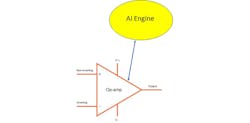Startup to Introduce AI-Enhanced Analog ICs
This article is part of the April 1st series in the Humor section of our Series Library.
Artificial intelligence (AI) is apparently everywhere, but thus far has eluded use with basic analog components. (Somewhat ironically, certain AI systems are using analog components for the implementation circuitry in addition to aiding analog-IC design, but that’s a story for another time.)
It all may soon change, though, thanks to a startup that hopes to develop analog ICs with AI-based enhancements (see figure). The company—tentatively dubbed AI4A (“artificial intelligence for analog”)—said it will start with basics, such as the ubiquitous building-block operational amplifier, or op amp.
How will AI play into the op-amp function? The company’s founder said that the AI-infused op amp will make intelligent decisions about what the input signal should be, based on experience, then substitute this value when the actual signal seems to be noisy, out of range, or otherwise corrupted.
In addition, if it senses op-amp “misbehavior” due to excessive common-mode voltage (CMV), offset drift, and other weaknesses, it will automatically take action based on a combination of preset algorithms as well as the dynamics of the situation.
AI Spreading to ADCs?
Using AI to enhance analog functions doesn’t end with this basic analog function. The company plans to extend the technology to more complex functions such as analog-to-digital converters (ADCs).
“The challenge is that the ADCs must quickly assess and digitize an unknown random signal from an unknown source, and this scenario can easily lead to errors,” said the spokesperson. “Our AI-enhanced converters will know what the input signal should be and provide a digitized version that makes sense for the situation, if need be.
It isn’t clear yet what the power or cost burden will be for these AI + analog devices. “That’s a function of process, die size, yield, and many other factors, some of which are still unknown and others which we can’t control,” added the spokesperson.
This article is part of the April 1st series in the Humor section of our Series Library.
References
Mythic, “Analog plus AI”
IBM, “Analog AI”
MIT, “New hardware offers faster computation for artificial intelligence, with much less energy”
Analog Devices, “Digital Processing Does Not Always Rule”
Here are the prior and next articles in the series
About the Author

Bill Schweber
Contributing Editor
Bill Schweber is an electronics engineer who has written three textbooks on electronic communications systems, as well as hundreds of technical articles, opinion columns, and product features. In past roles, he worked as a technical website manager for multiple topic-specific sites for EE Times, as well as both the Executive Editor and Analog Editor at EDN.
At Analog Devices Inc., Bill was in marketing communications (public relations). As a result, he has been on both sides of the technical PR function, presenting company products, stories, and messages to the media and also as the recipient of these.
Prior to the MarCom role at Analog, Bill was associate editor of their respected technical journal and worked in their product marketing and applications engineering groups. Before those roles, he was at Instron Corp., doing hands-on analog- and power-circuit design and systems integration for materials-testing machine controls.
Bill has an MSEE (Univ. of Mass) and BSEE (Columbia Univ.), is a Registered Professional Engineer, and holds an Advanced Class amateur radio license. He has also planned, written, and presented online courses on a variety of engineering topics, including MOSFET basics, ADC selection, and driving LEDs.





